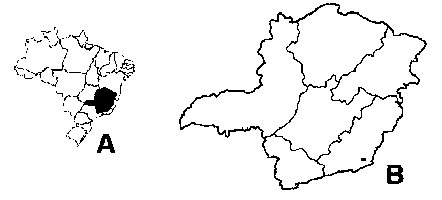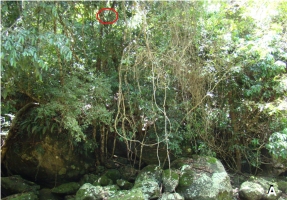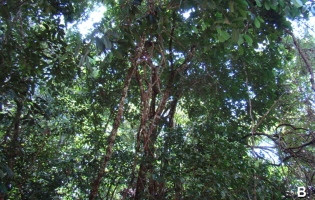IUCN/SSC Otter Specialist Group Bulletin

|
IUCN/SCC Otter Specialist Group Bulletin Volume 27 Issue 2 Pages 59 - 122 (June 2010) Citation: Silva, F.A.da and Quintela, F.M. (2010). Observations on the Climbing Habits of Neotropical Otter Lontra longicaudis. IUCN Otter Spec. Group Bull. 27 (2): 93 - 97 Observations on the Climbing Habits of Neotropical Otter Lontra longicaudis Fabiano Aguiar da Silva1 and Fernando Marques Quintela2 1Curso de Ciências Biológicas, Faculdades Integradas de Cataguases, Rua Romualdo Menezes, 701, Bairro Menezes, Cataguases, Minas Gerais, Brasil, CEP.36773-084. e-mail:biofaguiar@hotmail.com |
  |
|
Abstract: An individual of Lontra longicaudis was observed climbing a tree trunk till the height of ca. eight meters (trunk inclination=84.29º) about 50m away from the water in a southeastern Brazilian Atlantic Forest fragment. This behavior occurred after an interaction with the observer and may be related to defensive tactics in areas more distant from water bodies. |
| Keywords:arboreal stratum, Atlantic Forest, defensive behavior, neotropical otter |
| Française | Español | Portuguese |
The neotropical river otter Lontra longicaudis is a carnivore species adapted to semi-aquatic habits, which can be evidenced by its morphological characters such as dorsal-ventrally flattened tail and the presence of interdigital membranes (Emmons and Feer, 1997; Cheida et al., 2007; Carvalho-Júnior, 2007). However, other authors have described the utilization of arboreal structures in activities related to scent marking with feces and anal secretions (Spinola and Vaughan, 1995; Quadros and Monteiro-Filho, 2002; Kasper et al., 2004; 2008), besides the record of utilization of a hollowed treetop to shelter young in a flooded Amazonian forest (Santos et al., 2007). The present work reports the climbing behavior of Lontra longicaudis observed in an Atlantic Forest fragment in southeastern Brazil.
The Private Reserve of Nature Heritage (RPPN) Usina Maurício is located at the boundary of Leopoldina and Itamarati de Minas municipalities, Paraíba do Sul river basin, Minas Gerais State (Zona da Mata region), between the coordinates 21º27'50”S - 42º50'52”W and 21º29'10”S - 42º49'24”W (Figure 1). The RPPN hosts a system of pools and reservoirs, with rocky banks and riverbeds. The vegetation is composed of the Seasonal Semidecidual Tropical Forest. On 30 June 2009 at 08h15min an individual of L. longicaudis (indeterminate sex) was observed (FAS) climbing a tree trunk of Soroceae blonplandii (Baill.) Burger, Lanjouw & Boer (Moraceae) (total height=14m; diameter at breast height=20cm; altitude=226m; 21°28'15.2"S, 42°49'56.5"W) until the height of approximately eight meters (Figure 2). The trunk presented the inclination of 84.29º and the distance from water (a pool) was approximately 50m. After climbing, the individual stayed about eight minutes moving over the branches, vocalizing and watching the observer. Climbing down was performed head first until a lower segment of the trunk, from where the individual jumped to the ground. Back to the ground, the individual entered further the dense vegetation, moving even more away from the pool system.
It is important to note that the individual climbed the trunk soon after the approach of the observer. Therefore, this action could be related to an escape behavior after threat identification, being possible that L. longicaudis utilizes the arboreal stratum for refugee during dangerous situations in areas more distant from the water bodies. In these cases, climbing trees could represent a more efficient method of escape if compared to ground displacement through the dense submontane vegetation. The neotropical river otter have few natural predators, including anacondas (Eunectes), caimans (Caiman) and jaguars (Panthera onca) (Larivière, 1999). Therefore, utilization of higher arboreal stratum could also be related to observation and perception of environment around. On the other hand, arboreal stratum provides food resources (e.g. reptiles, nesting birds) which could be exploited by L. longicaudis.
Considering factors such as the height achieved by the individual, the high inclination degree of the tree trunk and its small diameter, it is reasonable to assume that L. longicaudis possesses natural climbing abilities, and the behavior reported here may occur frequently in nature. However, since the Neotropical river otter is rarely observed in its natural environments (Carvalho-Júnior, 2007), this behavioral aspect remained unknown till the present record. It is worth noting that encounters with L. longicaudis at greater distances from water bodies are even rarer and the behavior reported in the present study probably was triggered by an interaction with the observer.
Information on use of arboreal structures by L. longicaudis is scarce. Santos et al. (2007) reported the encounter of a cub at a natural tree cavity located in a height of 1.20m from the water surface in a seasonally flooded Amazonian forest. Kasper et al. (2004) found scent marks in fallen trunks close to the edge or projected to the river bed in southern Brazil. Fallen trunks also represented 49.2% of the sprainting sites found by Spinola and Vaughan (1995) in Costa Rica. Moreover, there are no available data concerning climbing habits of the neotropical river otter based on field observations. Thus, the present record contributes to the knowledge on behavior and climbing ability of L. longicaudis.
Acknowledgements - We are grateful to José M. da Silva, Aldinéa F. A. da Silva, Ricardo A. da Silva and Fausto A. P. Menta for incentive and logistic support, Jorge C. Medina for field support, Willian C. Ramos for English review.
REFERENCES
Carvalho-Júnior, O. (2007). No rastro da lontra brasileira. Bernúncia, Florianópolis.
Cheida, C.C., Nakano-Oliveira, E., Fusco-Costa, R., Rocha-Mendes, F., Quadros, J. (2006). Ordem Carnivora. In: Reis, N.R., Peracchi, A.L., Pedro, W.A., Lima, I.P. (Eds.). Mamíferos do Brasil. Universidade Estadual de Londrina, Londrina, Brasil, pp. 231-275.
Emmons, L.H, Feer, F. (1997). Neotropical rainforest mammals: A field guide. The University of Chicago Press, Chicago.
Kasper, K.B., Feldens, M.J., Salvi, J., Grillo, H.C.J. (2004). Estudo Preliminar sobre a ecologia de Lontra longicaudis no Vale do Taquari, Sul do Brasil. Rev. Bras. Zool. 21(1): 65-72.
Kasper, C.B., Bastazini, V.A.G., Salvi, J., Grillo, H.C.Z. (2008). Trophic ecology and the use of shelters and latrines by the Neotropical otter (Lontra longicaudis) in the Taquari Valley, Southern Brazil. Iheringia, Ser. Zool. 98(4): 469-474.
Larivière, S. (1999). Lontra longicaudis. Mammal. Species 609: 1-5.
Quadros, J., Monteiro-Filho, E.L.A. (2001). Sprainting sites of the neotropical otter, Lontra longicaudis, in an Atlantic Forest area of southern Brazil. Mast. Neotrop. 9(1): 39-46.
Santos, P.M.R.S., Kinupp, V.F., Colletto-Silva, A. (2007). Treetop shelter of a neotropical river otter cub (Lontra longicaudis - Carnivora: Mustelidae) in an Amazonian flooded forest.Acta Amaz. 37(2): 309-312.
Spinola, R.M., Vaughan, C. (1995). Adundancia relativa y actividad de marcaje de la nutria neotropical (Lutra longicaudis) en Costa Rica. Vida Silv. Neotrop., 4(1): 38-45.
Résumé : Des Observations sur les Habitudes Grimpeuses de la Loutre Neotropical Lontra longicaudis
Un individu de Lontra longicaudis a été remarqué grimpand le tronc d’une arbre jusqu’à la hauteur d’environ huit mètres (inclination du tronc = 84.29º), vers 50m de l’eau dans une partie de la Mata Atlântica au sud-est du Brésil. Ce comportement, s’est-il passé, après l’interaction avec l’observateur et peut être en relation à des tactiques défensives dans les aires les plus éloignées des corps d’eau.
Revenez au dessus
Resumen: Observaciones sobre el Comportamiento Escansorial de la Nutria Neotropical Lontra longicaudis
Un indivíduo de nutria neotropical Lontra longicaudis fue visto ascender un tronco de árbol hasta una altura de cerca de ocho metros (inclinación del tronco = 84.29°), a una distancia de aproximadamente 50m del agua en un fragmento de Mata Atlántica en sudeste de Brasil. Este comportamiento se produjo tras una interacción con el observador y puede estar relacionado a tácticas defensivas em áreas más lejanas a los cuerpos de água.
Vuelva a la tapa
Resumo: Observações sobre o Comportamento Escansorial da Lontra Neotropical Lontra longicaudis
Um indivíduo de Lontra longicaudis foi observado escalando um tronco de arvore até a altura aproximada de oito metros (inclinação do tronco=84.29º), a uma distância de cerca de 50m da água em um fragmento de Mata Atlântica no sudeste do Brasil. Este comportamento ocorreu após uma interação com o observador e pode estar relacionado a táticas defensivas em áreas mais distantes dos corpos d’água.
Top



